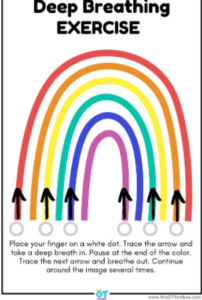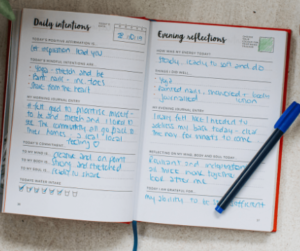Tips on Dealing with Stress
When we feel stressed, our bodies release stress hormones that cause our heart rate to rise, breathing to become faster and our muscles to tighten. To help slow down our breathing and make us feel calmer, we can practice some simple breathing exercises.
Deep Breathing Exercise
- Sit back in a comfortable position. You can close your eyes, but it isn’t necessary. TIP: When learning to use deep breathing, try placing one hand on your abdomen so you can feel it rise and fall with each breath. This will get you in the habit of taking large breaths, filling your lungs.
- Breathe in slowly through your nose. Time the inhalation to last 4 seconds. It’s fine to go even slower, if you prefer.
- Hold the air within your lungs, but not to the point of strain. 4 seconds is a good target to aim for.
- Pucker your lips, and slowly exhale through your mouth. Time the exhalation to last 6 seconds. TIP: For practice, try exhaling through a straw. This will get you in the habit of exhaling slowly.
- Repeat the breathing cycle for at least 2 minutes. Practice for 5 to 10 minutes for greater benefits.
Children benefit more from breathing exercises when there is movement involved, and “Rainbow Breathing” is a technique used with children. This technique uses a drawing or picture of a rainbow, and can be done in 2 ways.
Either 1) As you take in a deep, slow breath, trace the rainbow with your finger along and down one colour of the rainbow, then start at the bottom of the other end with a different colour as you breathe out.
Or 2) Breathe in as you trace the colour till you get to the top, them breathe out on the way down.
To help relax tension in the body when we feel stressed, a technique called “Progressive Muscle Relaxation” can help, especially when practised at night if you’re finding it hard to sleep. Progressive Muscle Relaxation is done by tensing groups of muscles as you breathe in, then relaxing them as you breathe out
- Lie comfortably on the floor or on your bed.
- Take a few deep breaths to relax.
- Breathe in. Tense the muscles of your feet.
- Breathe out. Release the tension in your feet.
- Breathe in. Tense your calf muscles.
- Breathe out. Release the tension in your calves.
- Work your way up your body. Tense each muscle group. This includes your legs, belly, chest, fingers, arms, shoulders, neck, and face.
There are various videos online that talk you through this method, and this one also has relaxing music and visuals that go along with it https://youtu.be/1nZEdqcGVzo
I hope you found my tips helpful.
Linda

Breathing Exercise for children:
Creating a paper boat or plane and practicing breathing in a fun way- seeing if they can keep the paper boat or plane on their tummy whilst watching it move up and down. Sometimes the boat can slide off the tummy which is the fun part and keeps the child mentally focused and away from feeling anxious. Deep breathing and concentration is focused on the tummy area. You have to be sure to keep it structured when they do giggle as not to go into full laughter as behind that is hyperactivity which can sometimes put them into overdrive.
Step 1: Make the paper boat/ plane together.
Step 2: Make a comfortable place to lay down, i.e. bean bags or pillow or somewhere they feel safe and comfortable. The adult can also take part which does encourage child to take part.
Step 4: Get comfortable but make sure child’s head is relaxed on pillow so they can see and focus on boat/aeroplane comfortably.
Step 5: Place boat on the tummy and start off with big deep breath in and see how high your tummy can lift the boat/ plane, then as you breathe out let’s see how slowly you can drop the boat down. Big breaths in slow breath out. You can set a 5 minute timer for this.
After the exercise you can open a discussion around how they feel now.
Louise
Journals
To help as a distraction or relaxation technique, I often recommend a creative gratitude journal as a wonderful way to combat stress and burnout. Focussing your attention on something you are grateful for. Spend some time periodically making art in your journal for this. Combining writing and images and art. Young people can make this a daily habit to enhance mood. Or it can be one time exercise by creating larger art piece that includes things that they may be grateful for no matter how small. It can be a smile a compliment a person or an object.

Helen Cosgrove, Secondary School Counsellor, The Exchange
What is anxiety?
Anxiety is thoughts, feelings and physical sensations around worry or feeling under threat. You might notice “what if” thoughts about things that might happen and physical sensations like being out of breath or a rapid heart rate. There are many kinds of anxiety such as generalised anxiety (worrying about things that might happen), social anxiety (worrying about what others may think of you or do to you) and health anxiety (worried that you or a loved one are or will get gravely ill).
It is important to remember that anxiety is a natural thing. It is useful to be able to be vigilant about a potential threat to keep yourself safe. We are biologically hardwired to respond to stressors or potential threats through our fight or flight response. Anxiety is how we experience this response. It only becomes an issue if it becomes unmanageable. If you find yourself worrying about things that are very unlikely to happen, your worry is out of proportion to the problem, you can’t stop thinking about the worry, you have panic attacks (where you feel like you are struggling to breathe) or your anxiety makes it hard to live your day-to-day life you might benefit from therapy or support.
What causes disordered anxiety?
It is important to remember that some anxiety is normal but disordered anxiety has been connected to several biological states, social issues and life events. Having more anxious tendencies may be partly inherited but even in this case people can be supported to manage their anxiety. Certain medications or recreational drugs may make people more anxious as well. If you have become more anxious after starting a new medication, you should take advice from your pharmacist or G.P.
Anxiety can also be caused by life events. Workplace stress, money worries, health scares or an accident may make a person feel anxious. People may also learn anxiety through life events. A classic example is people who were severely bullied at school being much more likely to be socially anxious than those who weren’t. They have learned that they may be mistreated or rejected by peers. This may not happen in another situation but the person might worry that it will. This places us in a position where they anticipate mistreatment and become anxious, even if there is no mistreatment coming. Anxiety is an attempt by the flight/flight system to keep us safe. When this system becomes disordered it may be hard for us to control our anxiety and it will impact our lives.
How do we work with anxiety?
There are a lot of ways therapy can help you regain control of your anxiety. Relaxation techniques or mindfulness exercises can help you send safe signals to your body. These can be breathing exercises, meditations, muscle relaxation or whatever works for you. We can use talk therapies to challenge the underlying thoughts or assumptions that may worsen anxiety. We can use exposure techniques to try and help you unlearn certain fears. Some people benefit from work on building confidence and accepting uncertainty. What you are experiencing is normal but if it is impacting your life you can get support to change it. Feel free to get in touch with us if this applies to you.

